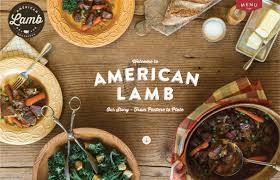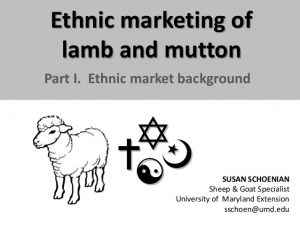First Published in Stockman Grass Farmer 2015
 KEYS TO MARKETING SHEEP & GOATS
KEYS TO MARKETING SHEEP & GOATS
When it comes to markets and marketing, the first and fundamental premise to always bear in mind is that in virtually all markets value is determined by supply and demand. Over the course of the past decade, demand in the meat goat market, and corresponding price appreciation outpaced lamb markets. In 2010 however, both lamb and goat markets hit unprecedented levels, surpassed only by 2011, with lambs considerably higher than goats. Although global supply and demand are certainly a major factor in what has been going on, a variety of other factors have influenced the lamb and goat markets over the course of the past year or two.
During that time period a perfect storm was brewing in the global lamb market. As countries like China and India have seen their economies grow and corresponding standards of living improve, there is greater demand for sources of protein, including lamb and goat. While this has certainly had an effect on the beef market, many ethnic groups in the global market actually prefer lamb and goat to beef. And while global demand for lamb has been growing, which is great news for countries like Australia and New Zealand that have worked hard both to encourage greater global demand, and to continually increase their market share, for a variety of reasons, global supply has simultaneously become much tighter. A majority of global supply-side issues can probably be attributed to weather-related conditions in Australia and New Zealand, including a multi-year drought, and other natural disasters that have affected their ability to expand supply to meet increased demand.
Couple these issues with the fact that a weaker U.S. dollar, and stronger Australian and New Zealand currencies (also denominated in Australian dollars (AUD) and New Zealand dollars (NZD)), encourage lamb importers to buy American lamb instead, creating even greater demand for American lamb in particular, which then becomes more reasonably priced compared to Australian and New Zealand lamb in global markets.
 Even in this country as a general rule (and recognizing that there are exceptions to every rule), both lamb and goat are primarily ethnic foods, rarely eaten by most mainstream, white Anglo-Saxon Americans. The reasons for this are several fold. One of the biggest reasons is the fact that many Americans have never even eaten lamb, and fewer yet have eaten goat. Prior to WWII, lamb was more of a staple in the American diet (although goat never has been). At this point, though, as a general rule, most younger American wives and mothers (who still do most of the cooking in this country) simply don’t cook lamb (or goat). In addition, compared to other red meats, it is often more expensive. I was recently talking to a younger generation Western sheep rancher. Out of curiosity, I asked him if they ate much lamb in their home. He said no, his wife hadn’t grown up with it, and didn’t really like it, so she didn’t cook it. He said that on a recent trip to San Francisco he felt obligated to support his industry so had considered eating lamb for dinner at the restaurant where they were dining – until he noticed that it was almost $50/plate.
Even in this country as a general rule (and recognizing that there are exceptions to every rule), both lamb and goat are primarily ethnic foods, rarely eaten by most mainstream, white Anglo-Saxon Americans. The reasons for this are several fold. One of the biggest reasons is the fact that many Americans have never even eaten lamb, and fewer yet have eaten goat. Prior to WWII, lamb was more of a staple in the American diet (although goat never has been). At this point, though, as a general rule, most younger American wives and mothers (who still do most of the cooking in this country) simply don’t cook lamb (or goat). In addition, compared to other red meats, it is often more expensive. I was recently talking to a younger generation Western sheep rancher. Out of curiosity, I asked him if they ate much lamb in their home. He said no, his wife hadn’t grown up with it, and didn’t really like it, so she didn’t cook it. He said that on a recent trip to San Francisco he felt obligated to support his industry so had considered eating lamb for dinner at the restaurant where they were dining – until he noticed that it was almost $50/plate.
One of the reasons a whole generation of Americans essentially turned the corner against eating lamb about the same time the American Sheep Industry started into its long decline after WWII was based on what many considered to be the bad experience of eating more mature and over-fat “mutton,” versus a prime lamb product. While some people really like mutton it is an acquired taste that most people don’t care for right at first.
The good news is that demand is slowly growing among some mainstream American market segments for both lamb and goat, with grass-fed and natural/organically produced lamb seeing even bigger growth. These segments primarily include “foodies” and affluent, well-educated empty-nesters (See SGF Lava Lake Marketing article, July 2011 issue). For the most part, however, any significant concentrations of these consumers live in more metropolitan areas. Although those demographics are slowly working their way to the heartland, any significant concentrated numbers are still a big issue in most places.
 Consequently, for a variety of reasons most lamb and goat consumed in the United States (and elsewhere) today, is eaten by ethnic groups, including everything from Jews to Greeks to Muslims, Basques and Hispanics, to Asians and Africans, who have all maintained a strong ethnic tradition of eating lamb and goat – particularly during their own religious and cultural holidays. This includes meat purchased directly from producers either at farmers markets, on the farm, or via the Internet, as well as from ethnic markets, and prepared and eaten at home, or consumed at ethnic restaurants. Although ethnic populations are also growing in some parts of the interior of this country, by far the biggest ethnic populations are on both coasts, and along the Southern border. So proximity to ethnic markets is a big consideration. If you’re doing a great job producing premium grass-fed lamb or goat out in the middle of nowhere, aside from potential Internet marketing, the fact that there might be a lot of ethnic consumers in NYC, Boston, Philadelphia and San Francisco may not do you much good. Something else to bear in mind regarding both lamb and goat is that most ethnics are not necessarily particularly concerned about production methods (i.e., don’t necessarily care whether they are produced on grass or grain). Even though they are willing to pay more for their ethnic preferences, they are still cost-conscious enough that they are seldom willing to pay a premium for grass-fed or organic.
Consequently, for a variety of reasons most lamb and goat consumed in the United States (and elsewhere) today, is eaten by ethnic groups, including everything from Jews to Greeks to Muslims, Basques and Hispanics, to Asians and Africans, who have all maintained a strong ethnic tradition of eating lamb and goat – particularly during their own religious and cultural holidays. This includes meat purchased directly from producers either at farmers markets, on the farm, or via the Internet, as well as from ethnic markets, and prepared and eaten at home, or consumed at ethnic restaurants. Although ethnic populations are also growing in some parts of the interior of this country, by far the biggest ethnic populations are on both coasts, and along the Southern border. So proximity to ethnic markets is a big consideration. If you’re doing a great job producing premium grass-fed lamb or goat out in the middle of nowhere, aside from potential Internet marketing, the fact that there might be a lot of ethnic consumers in NYC, Boston, Philadelphia and San Francisco may not do you much good. Something else to bear in mind regarding both lamb and goat is that most ethnics are not necessarily particularly concerned about production methods (i.e., don’t necessarily care whether they are produced on grass or grain). Even though they are willing to pay more for their ethnic preferences, they are still cost-conscious enough that they are seldom willing to pay a premium for grass-fed or organic.
Among ethnic groups, although there is, to some extent, considerable overlap between preferences for lamb versus goat, there are also some significant differences. The basic rule of thumb is that ethnic groups like to eat what they ate where they came from. If it was lamb, they want lamb. If it was goat, they want goat. If it is both, there’s usually quite a bit of overlap. A number of ethnic groups eat both lamb and goat, but their preference seems to depend on exactly where in their respective countries they originated, and other ethnic and religious considerations.
As we learned on our trip to Nova Scotia, Canada is a good place to learn about ethnic preferences. Toronto is said to be the most ethnically diverse city in the world, with strong market demand for both lamb and goat. What we learned in Nova Scotia was that many people with strong roots and close ties to the British Isles, (as well as Australia and/or New Zealand), which is the case with many Canadians in general, but particularly Nova Scotians, have a strong preference for lamb. But in a larger and more ethnically diverse city like Halifax, there may be increased demand for goat meat.
Regardless of ethnic background, however, consumption of both lamb and goat soars during traditional holiday periods, including both ethnic and religious holidays. Although there always seems to be stronger demand in the Thanksgiving through Christmas time frame (which may also correspond with a variety of other ethnic and religious holidays), the highest demand is around Easter time (which also corresponds with Passover). So market timing is really important for ethnic markets. And this has typically been a time of year that is challenging to meet market demand.
Another important consideration is animal size. While the conventional commodity lamb market might want a 120+ lb. lamb that, when processed, will yield 60+ lbs of packaged meat, many ethnic consumers will probably want something smaller, more in the 70-85 lb. range, and (and as opposed to mainstream Americans), they may want to buy the animal live so that they can have it slaughtered themselves in accordance with their own cultural and religious requirements and/or preferences. In the case of Jews, this includes Kosher considerations. In the case of Muslims, this includes Halal slaughter. In some cases, they may be willing to pay extra if all this can be done on your farm.
Something else to consider is that some ethnic groups like male animals intact. I learned some of this at the Ontario, California livestock auction that has a predominant Hispanic clientele. As I watched sheep and goats go through the auction, as opposed to a typical auction scenario where intact males are often discounted, especially after a certain age, because of the additional hassle of dealing with that issue, in Ontario the bidding was more active and the intact males always seemed to go for more money. Same was true for colored animals. They always seemed to go for more than the lighter colors, especially if they were black. Consequently, it pays to do plenty of homework, understand as many such variances as possible, and not take anything for granted.
In terms of applying and putting these observations and principles to good use in a production/marketing situation, what a person better look seriously at is what kind of major ethnic populations (if any) there are in the surrounding market area. In our case, although there weren’t any major populations of other ethnic groups nearby, the Hispanic population was growing locally, and Las Vegas, Nevada had developed a fairly substantial Hispanic population to service the construction and hospitality industries there. So, meat goats seemed like a better fit from a market demand standpoint at a time when there wasn’t near as much demand, locally, for lamb. On the other hand, Laura Sluder, a friend of ours, at Blue Sage Farm in Shoshone, Idaho, told us about a large population of new Iraqi refugees that had moved into the Boise, Idaho area. They weren’t necessarily interested in goat, but they told her that their group could probably take 1000 lambs/year.
So those are some of the kinds of things a person should want to know before ramping up production of one versus the other – what is the greatest local market demand for? Shouldn’t that always be one of the first and biggest questions? Yet I have met many producers who decided to go down one path or the other, based entirely on their own preferences, without giving much thought to local market demand factors.
So, if you’re considering sheep or goats, and trying to decide which would be the best fit, purely from a marketing perspective, consider the following questions: First and foremost, what is your best, closest and highest value market outlet? Who will you sell your product to? Is there an ethnic population that you can direct market to? Do they prefer sheep or goats? What other prime target market demographics do you have access to? In the end, market considerations should probably be the primary driver of production decisions.
You may also like
-
Hero guardian dog that killed 8 coyotes nominated for Farm Dog of the Year award
-
Feds storm Amish farm for selling traditionally grown meat, milk, produce
-
SNWA using illegally-held grazing permits to drive ranchers off Nevada range
-
Washington rancher showcases environmental benefits of raising livestock
-
To the do-gooders “rescuing” Idaho livestock guardian dogs, STOP IT!

